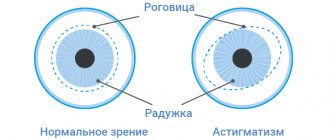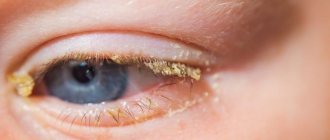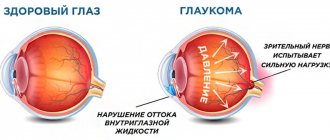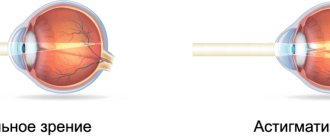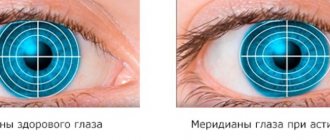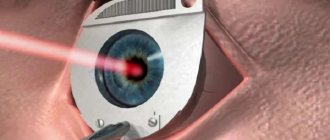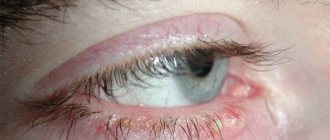The eye is one of the most important organs through which a person perceives the world. If it is damaged, the effectiveness of the other senses is lost. Perception occurs, but not in the way we would like.
Astigmatism is a pathology that appears due to distortion of the lens or cornea. Experts believe that astigmatism caused by a violation of the sphericity of the cornea significantly worsens the quality of vision, since it is the first component in which the refraction of light rays occurs. The degree of astigmatism is determined by the value characterizing the strength of optical refraction - diopters (D).
When determining the acuity and quality of vision, 3 degrees are determined:
- Weak. Vision decreases to 3 D.
- Average. Reduced visual acuity from 3 inclusive to 6 D.
- High. From 6 D and above.
The origin of the disease may vary. It can be congenital and occurs as a result of any pathological effects on the organ of vision, that is, the pathology is acquired. Congenital astigmatism is usually transmitted genetically, and there will definitely be people in the family with this pathology.
The cause of astigmatism lies in the improper formation of eye structures during its development. Children are born with a curved cornea and sometimes an irregular lens. Due to such deformations, the refraction of rays in these formations is disrupted, and the images recorded by the retina of the eye are distorted.
In newborns and infants, the degree of astigmatism rarely exceeds 0.5 D. This type is “functional”, or reversible. It does not have a serious effect on visual acuity, and by the age of one year it decreases. If the score is 1 D or higher, correction with glasses is required. Astigmatism detected after two years is accompanied by more serious disorders: deformation of the lens may occur.
Acquired astigmatism can develop in both adults and children. It can be the result of surgical interventions on the organ of vision, trauma, as well as certain diseases and conditions; infectious lesions, hyper- and hypovitaminosis, various etiologies of conjunctivitis.
Childbirth with astigmatism
articles:
Astigmatism is a violation of the natural sphericity of the cornea of the eyeball or the shape of the lens.
This problem is expressed in the formation of several foci on the retina and meridians of refraction of light rays - for this reason, a person will see the image of objects fuzzy and blurry.
Astigmatism during pregnancy is not an absolute indication for cesarean section, however, cases of complications of this disease with concomitant ailments may well be ophthalmological indications for cesarean section.
Types of astigmatism. Classification
Astigmatism can be either a congenital or acquired eye disease. According to the degree of complexity, the disease is distinguished: - weak - less than 3 diopters; - average - from 3 to 6 diopters; — high — more than 6 diopters. The degree of complexity of the defect is related to visual acuity.
The initial degree (up to 3 diopters) does not have a significant effect on the functioning of the eyeball.
The disease in many cases is combined with other pathologies of the visual system: - hypermetropic astigmatism - curvature of the cornea + farsightedness; — myopic astigmatism — corneal defect + myopia; - mixed astigmatism - the presence of signs of both myopia and hypermetropia.
Astigmatism and complications during pregnancy
Whether it is possible to give birth with astigmatism naturally without using a cesarean section will only be determined by a thorough examination by an ophthalmologist.
Farsighted astigmatism and childbirth are a very real combination, because the hypermetropic form does not threaten complications, the effect on the retina during pushing and contractions is insignificant, and there is no threat of detachment.
Childbirth with astigmatism and myopia requires special attention from specialists: simple and complex forms of myopic deformation of the cornea can lead to complete or partial retinal detachment. Complications can be caused by muscle tension and increased pressure during pushing and contractions.
To avoid detachment, they often resort to childbirth by cesarean section: during the operation, the mother’s body is not subject to physical stress and the retina does not detach. Detachment is a process during which the retina loses contact with the vascular network that feeds it.
Depending on the degree of alienation from the vessels, negative changes occur that affect visual acuity: distortion or decreased function is possible, and in particularly difficult cases, absolute blindness. Retinal detachment is also affected by intraocular pressure.
Myopic astigmatism is dangerous during childbirth; in some cases, during pregnancy planning, ophthalmologists do not recommend giving birth to a child due to the high probability of becoming completely blind and becoming disabled. Mixed astigmatism is also an indication for delivery by cesarean section due to the risks listed above. Whether a cesarean section is necessary for astigmatism in a particular case can be determined only after examining the fundus and measuring intraocular pressure.
Symptoms of astigmatism. What to pay attention to during pregnancy?
Signs of the disease are specific and easy to notice.
If you discover any of the following symptoms, you should contact an ophthalmologist for advice and additional examination: - noticeable blurred vision, difficulty perceiving objects at different distances, blurred or distorted images; - systematically occurring headaches; - rapid eye fatigue; - the membrane is irritated, the eyes become red or watery; — it’s difficult to concentrate your gaze while doing needlework, reading, or writing.
Preventive measures for astigmatism during pregnancy
Pregnancy is a test for a woman’s body as a whole. Atypical workload and overwork can lead to serious and sometimes irreversible damage to various organs.
To avoid deterioration of vision while carrying a child, it is necessary: - systematically attend routine preventive examinations with an ophthalmologist; - take care of proper lighting; This is especially true for doing small work, handicrafts or reading; - perform gymnastic exercises for the eyes; - minimize the time spent at the computer and watching TV, alternate this activity with periods of 10-15 minute rest; - pay attention to the diet and balance of nutrition; - give up bad habits: smoking, drinking alcohol. Treatment of myopic type astigmatism during pregnancy Conservative therapeutic measures during pregnancy do not differ from treatment in other situations: - vision correction with glasses; — correction of the defect using lenses; — hardware therapy. You should consult an ophthalmologist and choose a vision correction method, select lenses individually and wear them as recommended by your doctor.
Signs of retinal detachment and actions for this complication
Due to excessive load, detachment from the vascular network can begin both during pregnancy and during childbirth. A sign of this complication is psia (sparks, lightning before the eyes), distortion of the image, fluctuations, floaters.
If there is a suspicion of retinal detachment during pregnancy, the woman should be immediately hospitalized in a hospital. The likelihood of vision preservation depends on the speed of assistance provided. Due to the detachment of the retina, fluid is released, which speeds up the process.
In addition, nerve cells die at this time, and this is irreversible. Laser surgery is performed to repair the gap as soon as possible.
Astigmatism and natural childbirth are quite compatible in most cases, but with the myopic type, it is worth taking care of your future and preparing for the birth of a child by cesarean section - this method will save the vision of the mother of the newborn.
Latest materials in the section:
Hypnobirthing: what is it, what is special about the Mongan method
Hypnobirthing is an instinctive birth using techniques that promote relaxation.
How contractions begin
Girls who are preparing to become mothers for the first time often worry that they will not be able to notice the onset of labor in time. Moreover, sometimes pregnant women do not even notice the obvious...
Epidural anesthesia during childbirth
Epidural anesthesia (EA) is a type of neuraxial blockade: the effect of the drugs used is aimed at the conduction of the spinal cord roots. The method involves introducing...
Source: https://birth-info.ru/198/Rody-pri-astigmatizme/
Features of childhood astigmatism
A child with a congenital pathology cannot distinguish the correct visualization of objects from the incorrect one, because he has no idea about the real shape of objects in our world. If parents have not examined their child before the age of seven and have no idea about refractive error, the problem begins to manifest itself during school. The child constantly has a headache, it is difficult for him to distinguish letters in a book and write in a notebook. The kid refuses to do his homework due to headaches and improper focusing of his vision.
If a child squints his eyes and tilts his head in a special way to look at an object, this indicates a pathology of refraction.
The difficulty of treating astigmatism lies in the peculiar manifestation of the pathology: one eye may be affected by myopia, and the second is diagnosed with farsightedness. The child suffers due to refractive error, but is unable to explain what is happening to him. If parents are irresponsible about their child’s health, school doctors come to the rescue. Students in our country undergo regular medical examinations. If astigmatism is suspected, school doctors will issue a referral to an ophthalmologist for examination.
Symptoms of developing pathology in a small child:
- the baby is poorly oriented in space;
- while eating, the child carries the spoon/fork past his mouth;
- when asked to put toys in a box, he misses;
- The child cannot look at pictures in books for a long time and does not show interest in reading.
What should you be wary of?
Little children love to look at bright pictures in children's books and ask to tell them about the heroes of their favorite fairy tales. However, a child with astigmatism does not show interest in pictures and books because he cannot focus his vision and see the image in the correct form. Lack of interest in pictures should alert parents, because this indicates deviations in the visual apparatus.
We recommend reading: Useful eye exercises for myopic astigmatism.
Older children cannot watch cartoons due to eye pain. If the baby cannot speak well, parents should pay attention to frequent rubbing of the eyes with their fists. When pain or burning appears in the eyes, the baby instinctively brings his hands to his eyes and tries to eliminate the pain with touch.
For the same reason (pain in the eyes and the inability to focus vision on an object), the baby refuses to color or draw. You can also check the pathology of refraction while sculpting figures from plasticine: the baby cannot sculpt the figure due to improper focusing of vision. All of the above examples should alert vigilant parents.
Lens astigmatism
This pathology is rare. Why does the lens take on an irregular shape, which contributes to a distorted perception of the world? Because the eyeball develops faster than the lens itself, or the eyeball enlarges unevenly.
It is difficult to identify this pathology in a child, because it does not manifest itself in any way. From birth, the baby gets used to seeing a distorted picture of the world, which seems natural to him. In order not to miss time, parents should show the child to an ophthalmologist at 3, 6 and 12 months.
If no visual pathologies are detected, the child is shown to an ophthalmologist once a year during routine examinations. After entering school, school doctors carry out routine examinations.
Diagnosis of lens astigmatism differs from diagnosis of pathology of the corneal layer. The patient undergoes refractometry, during which the refractive power of the lens is studied. Next, a shadow test is carried out using special lenses, also to identify the refractive power of the lens. Visometry (the use of pictures or letters of different sizes) reveals visual acuity, myopia or farsightedness. Visometry is carried out with small children who can talk and recognize pictures of animals.
When diagnosing the corneal layer, attention is paid to topography, that is, measurements are taken of the curvature of the surface of the anterior part of the eyeball.
Astigmatism and childbirth - is it possible to give birth and what is the risk of losing vision?
Pathology in ophthalmological practice is divided into the following types:
- Correct . The main feature is the same refractive power within each of the meridians - conventional lines passing through the center of the eyeball along its surface. A flatter configuration of the horizontal meridian with a concave vertical one is considered characteristic. Being more common, it most often develops under the influence of genetic factors. Regular astigmatism, in turn, comes in several types, depending on the refractive properties of each of the conventional lines:
- Simple hyperopic or myopic - farsightedness or myopia, respectively, is diagnosed only vertically or horizontally.
- Complex hypermetropic or myopic - the degree of refractive changes on different meridians varies significantly.
- Mixed - the presence of hypermetropia and myopia in one eye at the same time.
- Incorrect . The difference in refractive power in this case is characteristic not only of two meridians, but also of individual sections of each of them. Also often two conditional lines are not perpendicular to each other. This option is practically not amenable to correction with glasses and is considered a direct indication for surgical intervention. Most often, it appears from birth as a symptom of severe systemic pathologies or becomes a consequence of serious injuries with the formation of scars on the cornea.
- Hardware treatment . It involves the use of certain simulators, devices and programs with video images to eliminate astigmatism and for the treatment of other eye pathologies. The benefit of these devices also lies in the fact that the child’s eyes are prepared for the stress of school, and therefore vision will not deteriorate under the influence of overwork.
- Gymnastics also effectively helps to cope with astigmatism . The most effective in this direction is Zhdanov’s gymnastics, which works in several directions: relaxes the eye muscles, then loads and trains them to work in the correct mode. There are certain exercises that will help solve the problem of astigmatism and reduce its effect on the eyes. Eye gymnastics according to Zhdanov
- Wearing products for correction . For younger ages, spectacle correction is prescribed, but for high school students, toric lenses can also be used.
- Laser correction is a painless and quick procedure for correcting astigmatism. It lasts about a quarter of an hour under local anesthetic and does not require suture material. After these manipulations, the tissues of the cornea or lens are quickly restored. At the same time, a noticeable improvement in visual function is observed within a couple of hours, and patients see final results within a week.
Treatment methods
Treatment methods for children are somewhat different from those for adults. This is explained by the child’s perseverance and patience, since some techniques require prolonged exposure, and children may not tolerate such a procedure.
Therefore, special conditions were created for them for the treatment of pathology:
The video shows the main method of treating astigmatism:
Treatment should be started only after consultation with a doctor, since some types of procedures may be harmful to the child and have contraindications. But there is no point in delaying the correction.
Signs of the disease
- sudden or noticeable deterioration of vision;
- blurred outlines of objects;
- image distortion;
- regular headache;
- eyes get tired quickly;
- redness of the eyes;
- regular lacrimation;
- Difficulty focusing your eyes while reading or doing handicrafts.
If you discover one or more signs in yourself, you should immediately contact a specialist. The earlier a problem is identified, the easier it is to stop it and take the necessary measures to reduce risks.
Prognosis for treatment of the disease
Of course, when starting to treat astigmatism in a child, parents are interested in how successfully astigmatism in children is treated. Causes, treatment, prognosis - all this information should be provided to parents by the attending physician.
If the disease is congenital, the severity of the disease may decrease with age. The degree of the disease stabilizes around the sixth year of a child’s life.
Timely and correct diagnosis, and subsequently appropriate treatment, will help to successfully cope with the problem and help the patient gain the ability to see well.
Should astigmatism be treated?
Parents often ask the question: “Will astigmatism go away on its own, and is this disease treatable in children or not?”
It is impossible to answer these questions unequivocally; it all depends on the age of the child and the severity of the pathological condition.
It happens that a slight visual impairment passes without a trace and does not entail any consequences, but sometimes the disease becomes severe and leads to serious complications.
Parents should understand that the question of the need and extent of astigmatism therapy is decided by an ophthalmologist individually for each child.
Children under one year of age most likely will not need any treatment; it will be enough to simply come for examination regularly and monitor the function of the organ of vision.
For older children, the doctor will advise correcting the pathology using conservative methods. Surgical treatment is suitable only for adults, after 18–20 years of life.
Experts consider astigmatism to be more of a pathological condition, a “refractive error of the eye,” than a disease. But this problem entails serious troubles for the child’s body. Therefore, doctors advise correcting astigmatism as early as possible, when the first symptoms of visual impairment appear.
Causes and symptoms
The following factors can provoke the development of astigmatism:
- Genetic predisposition. The congenital form of the pathology is predominantly inherited from parents who have similar problems with visual functions.
- Traumatic injuries. This includes contusions, eye injuries that result in displacement of the lens, and rupture of the cornea.
- Inflammatory eye pathologies. Astigmatism can be caused by keratitis, conjunctivitis, and blepharitis.
- Operations on the visual organs. Interventions during which an incision is made into the cornea often cause deformation. This can happen due to poor-quality sutures or their divergence.
If we talk about the symptoms that are characteristic of astigmatism during pregnancy, then patients complain of the following signs:
- severe decrease in visual functions;
- unclear picture before the eyes;
- headaches;
- increased fatigue of the visual organs;
- redness of the mucous membrane of the eyes.
Source: https://neotravlen.ru/beremennost/astigmatizm-i-rody-mozhno-li-rozhat-i-kakov-risk-poteryat-zrenie.html
Symptoms of astigmatism
Common signs of astigmatism include the following:
- Unfocused perception of visual images. Images appear blurry and unclear.
- Severe fatigue, which manifests itself as a result of visual stress.
- When reading for a long time or otherwise straining the eyes, objects become double.
- Astigmatism in both eyes is often accompanied by redness and swelling in the eyelid area.
- Increased sensitivity to light.
What is the danger of astigmatism if it is not corrected? Lack of timely correction, especially at an early age, can cause significant vision loss. That is why, if you are predisposed to developing astigmatism, it is important to undergo regular ophthalmological examinations.
Does astigmatism affect childbirth?
IT IS IMPORTANT TO KNOW! An effective remedy for restoring vision without surgery or doctors, recommended by our readers! Read more…
With this disease of the visual organs, there is a violation of the correct sphericity of the cornea of the eyeball. In some situations this concerns the lens.
Because of this, several focuses are formed on the retina at once, as well as refractions of light rays, which leads to the fact that a person cannot look at things clearly, but see only cloudy silhouettes. Astigmatism and labor are a possible combination, as this diagnosis is not considered a compelling reason for cesarean section.
But there are certain situations in which the worsening of this disease, together with accompanying indications, can become an obstacle to the natural birth of a child.
Classification
This disease can be either acquired or congenital. In most cases, it is combined with other ailments of the visual organs.
- Myopic astigmatism - in this variant, a corneal defect is combined with myopia.
- Hyperopic - with this astigmatism there is not only curvature of the cornea, but also farsightedness.
- Mixed - the presence of both previous points.
There are three degrees of distribution, which depend on the presence of visual acuity:
- weak - less than 3 diopters;
- average - from 3 to 6;
- high - more than 6.
Pregnancy with a diagnosis of astigmatism
Only after a detailed examination by an ophthalmologist can one determine whether it is permissible to give birth naturally. Farsighted astigmatism during pregnancy is an easier situation, since complications do not threaten. Pushing and contractions do not significantly affect the retina, so there is no danger of detachment.
If it comes to myopic astigmatism, then special attention from experts will be needed here, since this option threatens partial or complete detachment of the retina.
This is provoked by pushing and contractions, which are characterized by increased pressure and muscle tension.
To protect yourself from such consequences, doctors often recommend a cesarean section, since during this procedure the mother’s body is not subjected to such a heavy load.
Complications
The greatest danger is a detachment, due to which the retina ceases to contact the vascular network that nourishes it.
The alienation of vessels can vary in area, and this is what creates the effect of transformations in visual acuity.
In some cases, this option is reduced or distorted, and in particularly severe situations, complete blindness may occur. Another significant factor for detachment is intraocular pressure.
Astigmatism with myopia can become dangerous not only during the birth process, but also during pregnancy. In the most complex forms, some doctors dissuade mothers from pregnancy and childbirth, since the likelihood of going blind and remaining disabled is quite high.
The mixed form of astigmatism is also considered a reason for cesarean section, since all the threats listed above also apply to this group. But each specific situation and the decision on it are discussed only after examining the fundus and subsequent measurement of intraocular pressure.
Complications and actions
Since the body is under stress throughout pregnancy, and not just during labor, retinal detachment can occur at any time.
Indeed, in addition to this, the expectant mother may be worried about high blood pressure, which can also cause detachment.
This can be felt due to photopsia, in which the picture becomes distorted, cloudiness, sparks, lightning before the eyes, and vibrations will be noted.
If this symptom is suspected, the expectant mother should be urgently transferred to a hospital. The sooner help is provided, the greater the likelihood of saving vision.
When peeling, there will be liquid secretions that contribute to the development of this process. During this same period, the death of nerve cells begins, and this is irreparable.
It will be necessary to carry out a laser procedure in the near future, thanks to which the gap will be sealed.
We recommend!
To treat eyes without surgery, our readers successfully use a proven method. Having carefully studied it, we decided to offer it to your attention. Read more…
Signs
The symptoms of this eye disease are quite specific, so they are difficult to miss:
- A sharp deterioration in visual ability.
- Difficulty perceiving objects at different distances.
- Frequent headache.
- Distortion or blurring of appearance.
- My eyes began to tire faster.
- Tearfulness.
- Redness of the eye shell, its irritation.
- Difficulty concentrating while doing needlework or reading.
After detecting them, immediately seek examination from a doctor, who will promptly detect the problem and begin solving it.
Treatment of myopic astigmatism
During pregnancy, therapy is exactly the same as in a standard situation. The following measures must be taken:
- correction with lenses;
- correction using glasses;
- hardware therapy.
During your consultation, your ophthalmologist will help you choose the best method for correcting your vision defect. Lenses are selected only on an individual order, and are always worn exclusively at the insistence of the attending physician.
Prevention
Carrying a child is already a test for the female body. Increased stress, accompanied by overwork, often leads to serious problems in organ dysfunction.
To preserve your vision during this period, you need to follow these recommendations:
- Perform special exercises for the eyes.
- Come for a routine examination to an ophthalmologist in a systematic manner.
- Make sure there is adequate lighting everywhere. Especially where minor work or reading is carried out.
- Balance your daily routine and diet.
- Watch less TV and work on the computer. If necessary, be sure to take a break.
- Do not aggravate the condition with bad habits - drinking alcoholic beverages and smoking.
Astigmatism is quite compatible with pregnancy and natural childbirth in most cases. But if you have a myopic form of this disease, then it is better to protect yourself and the future of the child and prepare for a caesarean section.
By secret
- Incredible... You can cure your eyes without surgery!
- This time.
- No trips to the doctors!
- That's two.
- In less than a month!
- That's three.
Follow the link and find out how our subscribers do it!
Source: https://aokulist.ru/zabolevaniya/astigmatizm/est-li-osobennosti-dlya-rodov-pri-astigmatizme.html
Pregnancy with a diagnosis of astigmatism
Only after a detailed examination by an ophthalmologist can one determine whether it is permissible to give birth naturally. Farsighted astigmatism during pregnancy is an easier situation, since complications do not threaten. Pushing and contractions do not significantly affect the retina, so there is no danger of detachment.
If it comes to myopic astigmatism, then special attention from experts will be needed here, since this option threatens partial or complete detachment of the retina. This is provoked by pushing and contractions, which are characterized by increased pressure and muscle tension. To protect yourself from such consequences, doctors often recommend a cesarean section, since during this procedure the mother’s body is not subjected to such a heavy load.
Astigmatism during pregnancy and childbirth: is it inherited?
With this disease of the visual organs, there is a violation of the correct sphericity of the cornea of the eyeball.
In some situations this concerns the lens. Because of this, several focuses are formed on the retina at once, as well as refractions of light rays, which leads to the fact that a person cannot look at things clearly, but see only cloudy silhouettes. Astigmatism and labor are a possible combination, as this diagnosis is not considered a compelling reason for cesarean section.
But there are certain situations in which the worsening of this disease, together with accompanying indications, can become an obstacle to the natural birth of a child.
Reasons for appearance
The cornea and lens of a healthy eye have a smooth, spherical surface. With the development of astigmatism, this sphericity is disrupted and light rays passing through the deformed lens or cornea are focused on the retina not at one point, but at several.
Objects are not clearly perceived by the eye. The most common cause of the disease is heredity. Astigmatism can also be acquired. Its appearance is facilitated by cicatricial changes in the cornea, which occur as a result of eye injury.
Astigmatism can be caused by ophthalmological operations, inflammatory and degenerative processes, and corneal clouding. Astigmatism is quite often combined with farsightedness (hypermetropic astigmatism) or myopia (myopic astigmatism).
There is so-called mixed astigmatism, which combines elements of farsightedness and myopia. With mixed astigmatism, one part of the light beam is concentrated behind the retina, and the other in front of it.
Diagnostics
You can suspect the presence of astigmatism based on a person’s characteristic complaints. The diagnostic program usually includes determination of visual acuity and refraction, skiascopy, measurement of intraocular pressure, and biomicroscopy.
The most accessible and fairly reliable diagnostic method is skiascopy. It allows you to measure refraction in different meridians in just a few minutes and find out the type, type and degree of astigmatism. To determine refraction, you can also use a more modern method - refractometry.
In the diagnosis of corneal astigmatism, ophthalmometry and computer keratotopography are of great importance. Normally, the cornea should be perfectly round and look like a smooth sphere. In the case of astigmatism, these techniques reveal measurements of the curvature of the cornea or various irregularities on it.
To confirm or refute the presence of astigmatism in a patient, as well as to determine its degree, the ophthalmologist examines the fundus of the eye, conducts a visual clarity test (visiometry), and measures eye pressure.
As additional studies, the patient may be prescribed directions for an ultrasound examination of the eye, a study of its structures (biomicroscopy), and determination of the level of deformation of the cornea and lens (ophthalmometry).
The initial examination occurs at birth, but it is impossible to detect pathology immediately. In advanced and specially equipped rooms for this purpose, poor vision of the eyes can be identified as early as three months from birth.
Attention! The earlier myopia is diagnosed, the better. If the pathology is not noticed at first, it can lead to deterioration of vision.
The diagnosis of astigmatism is made by an ophthalmologist after examining the patient, checking visual acuity using special tables and determining the difference in the curvature of the cornea - special cylindrical lenses are used for this purpose.
Source: https://AptekaTamara.ru/glaza-bolezni/mozhno-li-rozhat-s-astigmatizmom.html
Astigmatism during pregnancy
Not in all situations, astigmatism during pregnancy is considered an indication for a cesarean section. However, such cases occur quite often, for example, if the disease is complicated by concomitant pathologies. This disease is characterized by a violation of the natural sphericity of the cornea or lens, and if it is complicated by myopia, natural childbirth is practically excluded.
Consequences during pregnancy
A complication during pregnancy is retinal detachment, which can lead to complete loss of vision.
The most serious complication characteristic of astigmatism in pregnant women is retinal detachment, as a result of which contact with the vascular network that nourishes it is disrupted.
This often results in complete loss of visual function. If a pregnant woman is diagnosed with myopic astigmatism, danger awaits not only during childbirth, but also during pregnancy.
In such situations, some doctors do not recommend getting pregnant at all, since the likelihood of completely losing vision is extremely high.
Is it possible to give birth naturally?
Whether astigmatism and childbirth are compatible is determined in each specific case exclusively by an ophthalmologist who conducts the required studies.
If we talk about the farsighted type of the disease, then when it is detected, almost every woman is allowed to give birth naturally.
This is due to the fact that such a pathology does not threaten consequences, since the impact on the retina during contractions and pushing is minimal.
Astigmatism complicated by myopia requires increased medical attention. Deformation of the cornea often causes partial or complete retinal detachment.
This can be caused by muscle tension or increased pressure during contractions.
To prevent this, pregnant women are prescribed a caesarean section, since the woman’s body does not strain during the surgery.
How is the treatment carried out?
If surgical intervention is not possible, vision correction using optics is prescribed.
Treatment of pathology is directly related to its type. Optical correction or surgical intervention may be prescribed.
The first therapeutic method does not cure the disease, but only improves vision by wearing glasses or contact lenses.
They are prescribed when it is not possible to perform surgery in order to preserve visual functions at a sufficient level until it becomes possible to prescribe surgical intervention.
If astigmatism is diagnosed in a mild stage up to 2 diopters, special exercises for the visual organs, glasses or contact lenses are prescribed. Doctors from the Muldashev eye clinic note that it is better to resort to the help of the latter. If we talk about operational techniques, the following options are often used:
- Keratotomy. During surgery, the doctor cuts the cornea and implants an artificial lens. The advantage of this type of operation is the complete return of visual functions. The disadvantages include a long rehabilitation period.
- Photorefractive keratectomy. The intervention is carried out using laser beams that change the deformation of the cornea. This technique also requires a long recovery; in addition, the possibility of clouding of the central area of the cornea cannot be ruled out.
- Keratomileusis. Visual functions are corrected with an excimer laser. It is considered the safest intervention during pregnancy.
Preventive actions
Carrying out gymnastics for the eyes and creating comfortable refreshment will help preserve visual functions.
To prevent deterioration of visual functions, it is important for pregnant women to systematically do special exercises for the visual organs.
You should also visit an ophthalmologist at least once a month, who will help identify visual impairments at the initial stages. The patient needs to create eye-friendly lighting throughout the house, especially in places where she reads.
Ophthalmologists do not recommend reading while lying down, especially in dim light.
Diet is also important for normal vision. The menu should contain a sufficient amount of food that is rich in vitamins and microelements.
Carrots, fish, parsley, pumpkin, nuts and citrus fruits are good for the eyes, if there are no allergic reactions.
You should not stay in front of a computer screen for a long time, however, if necessary, it is important to systematically take breaks and do gymnastics.
Preventive measures to prevent the occurrence of astigmatism are also required for the born child.
With it you will need to perform eye exercises, strictly control your rest and work schedule, and limit the use of mobile gadgets. Physical activity will be beneficial, but you should not abuse training.
It is important for parents not to forget about the baby’s healthy diet, which should contain vegetables and fruits, complex carbohydrates, vegetable fats and proteins.
Source: https://EtoGlaza.ru/bolezni/ast/astigmatizm-u-beremennyh.html
Therapy
Astigmatism is not a death sentence; refraction can be significantly improved using various methods. With a slight curvature of the corneal layer, simple exercises or wearing contact lenses will help. Laser correction of the corneal layer and lens is carried out only after 17-18 years, when the fundus of the eye is fully formed. Until this point, the child is prescribed contact lenses or special glasses with cylindrical lenses.
A distinctive feature of astigmatism is the lack of progression of the disease, so regular wearing of special optics can significantly correct the situation and control the pathology.
However, we should not forget that untreated astigmatism in a timely manner leads to other serious visual pathologies - lazy eye and strabismus. Therefore, the task of each parent is to comprehensively examine the baby not only with a pediatrician and orthopedist, but also with an ophthalmologist.
In difficult cases, surgery is performed to replace the natural lens with an artificial one. You should not be afraid of such operations; they are carried out using modern equipment with constant monitoring of the condition of the visual organs. After replacing the lens or leveling the corneal layer with a laser, vision is restored by almost 100%. There are complications, but in exceptional cases.
Spectacle correction
The use of special glasses restores clarity of visualization and relieves fatigue and pain in the visual organs. Wearing glasses also prevents headaches that accompany astigmatism. It is impossible to completely get rid of refractive pathology with the help of glasses, so most patients choose laser correction after the age of eighteen. The choice of laser correction is also due to the inconvenience of constant use of glasses, and some patients categorically cannot tolerate them for psychological reasons.
Note! Incorrectly selected optics contribute to the deterioration of visual functions.
Shy teenagers try to avoid wearing glasses due to emotional and psychological discomfort. Constant mental stress provokes headaches, discomfort in the eyes and the desire to get rid of glasses. In this case, contact lenses come to the rescue.
Contact optics
The lenses are invisible to the eyes and therefore do not cause psychological stress. Contact optics not only allow you to look aesthetically pleasing, but also provide complete freedom of movement. This is especially valuable for active teenagers.
Lenses have their drawbacks, but they do not relate to aesthetics and freedom of movement. Teenagers are willing to endure daily care for contact lenses and experience discomfort when putting on/removing lenses, just so as not to look inferior in the eyes of their peers.
However, lenses also have advantages over glasses: they provide full lateral vision. This allows a person to better navigate space and perceive the world in a three-dimensional image. Glasses cannot provide a full-fledged three-dimensional image of the world due to limitations in lateral vision.
Modern ophthalmology offers an innovative way to correct astigmatism using night lenses. They need to be worn only during night sleep; the lenses are removed in the morning. A specially designed rigid structure puts pressure on the corneal layer, leveling pathological defects. However, by evening the cornea takes on its natural shape, so the correction only works for a while. But this is enough to feel like a full-fledged person - without glasses and contacts. Rigid night lenses are used for corneal astigmatism.
The disadvantage of contact optics is the prohibition of wearing them during ARVI and conjunctivitis. Also, lenses cannot be used for certain infectious ophthalmological diseases in a chronic form. In this case, correction is carried out using special glasses.
Lenses for children
At what age can a child wear contact lenses? Ophthalmologists believe that after reaching 13-14 years of age, a child can purchase contact optics. If a child is characterized by increased responsibility at the age of 12, then he can already be trusted to wear contact lenses and care for them.
The use of lenses requires increased responsibility for visual hygiene, timely replacement of optics and compliance with the rules for storing/cleaning lenses. Young children do not realize that the use of lenses can damage the mucous membrane of the eyes when touched with their hands. A child can get dirt into their eyes if they rub them with unwashed hands.
During adolescence, children become more responsible, but they must be taught how to use contact products correctly. Until a teenager understands all the intricacies of using, cleaning and storing contact optics, adult supervision is necessary. You should not go to bed wearing daily lenses, as this will cause oxygen starvation (hypoxia) of the tissues of the visual apparatus. It is also prohibited to exceed the time of use of contact lenses and to replace them in a timely manner.
The teenager needs to be explained that when the mucous membrane of the eyes dries out, the use of moisturizing drops is required. This is necessary so that irritation of the mucous membrane does not develop into conjunctivitis. An adult child can independently administer eye drops, apply them as needed, and store them correctly. It is unlikely that it will be possible to agree on this with a younger child, so doctors prescribe glasses instead of lenses.
Laser correction
The operation is performed after the formation of the fundus. Until this moment, any invasive technique will not be successful: the eye is in the stage of formation and change of internal structures. To correct the corneal layer, the Lasik method is used - “evaporation” of the excess corneal layer. For lens astigmatism, an artificial lens is implanted.
When correcting the topography of the corneal layer, a laser beam is used to straighten the curved surface. No special preparation for the operation is required; the manipulation is performed under local anesthesia; no stitches are required after the operation. Rehabilitation after invasive intervention is quick, no complications are observed.
Who is indicated for artificial lens replacement? Ophthalmologists advise carrying out this procedure after 45 years, this is the most favorable time for a planned operation. It is not cost-effective to make a replacement earlier, but after the specified age it is not always justified. Artificial lenses are made from material that is biologically compatible with eye tissue. They perfectly replace the natural lens, which is the crystalline lens, and provide high-quality vision.
Gymnastics for the eyes
Astigmatism cannot be treated with exercises or wearing glasses/lenses. You can restore 100% vision only with the help of invasive correction methods. However, gymnastic exercises are a prevention of ophthalmological pathologies caused by incorrect refraction. Therefore, parents should pay special attention not only to the hygiene of the child’s visual organs, but also to the timely implementation of exercises to relieve tension from the visual apparatus.
Eye exercises:
- Movement of the eyes up and down and left and right with closed and open eyelids.
- Rotate your eyes clockwise, then counterclockwise.
- Look alternately at the tip of the finger of an outstretched hand, and then out the window at a distant object.
- Other exercises as recommended by an ophthalmologist.
After performing each exercise, it is recommended to blink at a fast pace for a minute or two.
In addition to exercises and regular relief of the visual apparatus from overstrain, vitamin nutrition is recommended. Blueberry berries/leaves in any form (fresh, frozen, dry), carrot juice, herbs, fresh fruits and vegetables are good for the eyes. A balanced diet and consumption of vitamin complexes will help strengthen the optical apparatus and reduce the likelihood of developing serious ophthalmological diseases.
Does astigmatism affect childbirth? Is it possible to give birth with astigmatism?
This disease can be either acquired or congenital. In most cases, it is combined with other ailments of the visual organs.
- Myopic astigmatism - in this variant, a corneal defect is combined with myopia.
- Hyperopic - with this astigmatism there is not only curvature of the cornea, but also farsightedness.
- Mixed - the presence of both previous points.
There are three degrees of distribution, which depend on the presence of visual acuity:
- weak - less than 3 diopters;
- average - from 3 to 6;
- high - more than 6.
Hereditary eye diseases
Many young mothers are afraid that their chronic illnesses can be inherited by their baby.
Is it so? Most modern ophthalmologists adhere to this opinion, and believe that the disease can still be transmitted from mother to child.
In some cases, astigmatism is acquired, but if the mother or father suffers from it, the child is very likely to develop a deviation.
The disease is mainly corrected with glasses and contact lenses. However, it is possible to get rid of the disease permanently only with the help of laser intervention.
